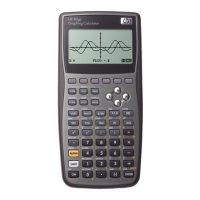14-62 Computer Algebra System (CAS)
CAS Functions on the CMDS menu
When you are in the
Equation Writer and press
, a menu of
the full set of CAS functions
available to you is
displayed. Many of the
functions in this menu
match the functions available from the soft-key menus in
the Equation Writer; but there are other functions that are
only available from this menu. This section describes the
additional CAS functions that are available when you
press in the Equation Writer. (See the
previous section for other CAS commands.)
ABCUV This command applies the Bézout identity like EGCD, but
the arguments are three polynomials A, B and C. (C must
be a multiple of GCD(A,B).)
ABCUV(A[X], B[X], C[X]) returns U[X] AND V[X], where U
and V satisfy:
C[X] = U[X] · A[X] + V[X] · B[X]
Example 1
Typing:
ABCUV(X
2
+ 2 · X + 1, X
2
– 1, X + 1)
gives:
CHINREM Chinese Remainders: CHINREM has two sets of two
polynomials as arguments, each separated by AND.
CHINREM((A(X) AND R(X), B(X) AND Q(X)) returns an
AND with two polynomials as components: P(X) and S(X).
The polynomials P(X) and S(X) satisfy the following
relations when GCD(R(X),Q(X)) = 1:
S(X) = R(X) · Q(X),
P(X) = A(X) (modR(X)) and P(X) = B(X) (modQ(X)).
There is always a solution, P(X), if R(X) and Q(X) are
mutually primes and all solutions are congruent modulo
S(X) = R(X) · Q(X).
--
AND
-
–
hp40g+.book Page 62 Friday, December 9, 2005 12:27 AM

